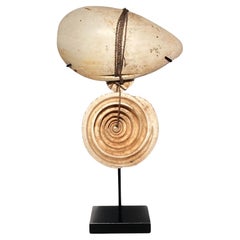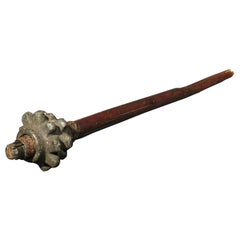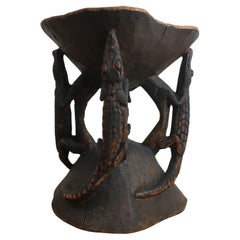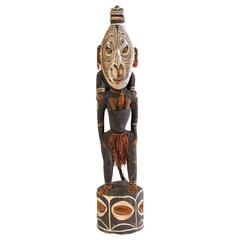Papua New Guinean Furniture
1
to
1
1
1
1
3
71
16
40
2
1
2
1
1
1
74
51,955
15,981
15,618
10,365
Period: 1960s
Place of Origin: Papua New Guinean
Pendant in Shell from Papua-New-Guinea
Located in Schellebelle, BE
Beautiful pendant made out of 3 different Shell species,
from Papua-New-Guinea from the 1960 ies,
the shells have a good and old patina and shine,
the pendant was used during ceremon...
Category
1960s Vintage Papua New Guinean Furniture
Materials
Shell
Related Items
Papua new Guinea Sepik Turtle stool Head Rest Oceanic Asian Tribal Art
Located in London, GB
Sepik Turtle stool Head Rest Oceanic Polynesian Australian
A cute small stool or Headrest carved in the form of a turtle from the Sepik region of Papua new Guinea
A beautiful objec...
Category
Mid-20th Century Papua New Guinean Furniture
Materials
Slate
H 5.91 in W 11.82 in D 5.91 in
A Rare Papua New Guinea Kukukuku 'Pineapple' Stone War Club, Eastern Highlands
Located in Ottawa, Ontario
This rare antique Kukukuku (pronounced "cookah-cookah") war club is from the remote Morobe Province located within the Eastern Highlands of Papua New Guinea.
The head is carved from...
Category
Early 20th Century Tribal Papua New Guinean Furniture
Materials
Stone
H 4.5 in W 26 in D 4.5 in
Antique Ethnic Artifact Sepik River Cassowary Bone from Papua New Guinea
Located in North Hollywood, CA
Antique Ethnic Artifact Sepik River Cassowary Bone from Papua New Guinea
For many groups in Papua New Guinea, bone was an important medium for making tools of all types. This artifact is made from leg bone of a cassowary, a large, flightless, and extremely dangerous, bird.
Cassowaries also play an important role in the mythology of groups in the Sepik River area.
Though no longer used these bone artifacts are still used ceremonially. They often play important roles in male initiation and other rituals. They are also worn as personal adornment by tucking them into a band of braided fibers worn around the upper arm.
Antique Ethnic Bone Cassowary Artifact with minimal carving and incised design confined to the joint end.
A small hole has been drilled through from both sides of the top and presumably for the threading of a cord.
The bone has been partially divided near the top and to form two prongs that project down the back of the dagger possibly allowing the user to wear is tuck into a waist band or belt.
Origin Papua New Guinea Maprik Dist Area
From the Art Collection of Marian and John Scott, acquired in 1962.
Similar items are in display in the Timothy S. Y. Lam Museum of Anthropology.
Purchased from the amazing private collection of Mark Lissauer who spent his life collecting niche ethnographic pieces.
About Mark Lissauer:
Mark Lissauer spent forty years travelling abroad for months at a time collecting ethnographic artefacts primarily from New Guinea and the islands of the West Pacific, and from Asia and Himalayan countries. Fluent in five languages and having in the course of business travelled to more than forty countries, Mark is well-known to museums and art-collectors around the world for his long career and his interesting and diverse collection of rare ethnographic material.
Mark knows the origin and symbolism of each piece. Through extensive research and more than ninety trips around the globe, Mark familiarised himself with the traditions of the various cultures he visited in order to understand the meaning of each object to its region and tribe. His home has a specialist library and several rooms are filled with tribal carvings, textiles and ethnographica.
He acquired his first tribal piece in 1948 during a business trip to Milne Bay, New Guinea, and has since documented the acquisition of some 35,000 items. Several thousands of these have been sold to important private collections and museums worldwide, including the Rockefeller Museum, the British Museum and the Musée National des Arts d’Afrique et d’Océanie, now incorporated into the Louvre Museum.
Estimator certificate of authenticity by Wayne Heathcote Tribal Art Dealer and Expert.
Heathcote has a flash gallery in Brussels, where much of the tribal art business is centred, and is an expert at Sotheby's tribal art sale...
Category
Early 20th Century Folk Art Papua New Guinean Furniture
Materials
Bone
A Rare Papua New Guinea Kukukuku War Club, Eastern Highlands - Morobe Province
Located in Ottawa, Ontario
This rare antique Kukukuku (pronounced "cookah-cookah") war club originates from the Morobe Province, which is a very remote area located within the Eastern Highlands of Papua New Gu...
Category
Early 20th Century Tribal Papua New Guinean Furniture
Materials
Stone
H 5.5 in W 9 in D 26 in
Yam Ancestor Figure TOTEM Pole Papua New Guinea with Provenance
Located in Atlanta, GA
A yam ancestor TOTEM pole from the mid-Sepik River region of Papua New Guinea. Carved out of a solid wood by the Abelam people, who cultivated yams as their main crop, the pole featu...
Category
Early 20th Century Tribal Papua New Guinean Furniture
Materials
Wood
Large Woven Painted Basketry Wall Mask Blackwater Rivers, Papua New Guinea
Located in Point Richmond, CA
Large woven painted basketry wall mask Blackwater rivers area, Papua New Guinea. With open expressive mouth and mask fringed with feathers, striking mask that easily hangs on the wal...
Category
Mid-20th Century Tribal Papua New Guinean Furniture
Materials
Organic Material
20th Century Tribal Bamboo Comb, Morobe Province, Papua New Guinea
Located in Point Richmond, CA
Mid to late 20th century incised bamboo comb, Huon Gulf, Morobe Province, Papua New Guinea
This large incised comb is typical of the bamboo combs of the Huon Gulf area. This parti...
Category
Late 20th Century Tribal Papua New Guinean Furniture
Materials
Bamboo
Pair of Oceanic War Shields on Stands from Papua New Guinea
Located in Atlanta, GA
A pair of Papua New Guinea wooden shields on custom stands from the mid 20th century. These oceanic war shields were not only created for protecting oneself for tribal warfare, but also in ancestral and ritual worship. They are adorn in various motifs, coloring and symbolism, intended to protect the carrier from magic and bring fear to the opponent. The shorter shield is from the Mendi area within the Southern Highlands. The taller shield originates from the Melpa tribe of the Western Highlands (Mount Hagen and Wahgi Valley), an area which was not discovered by the outside world until three Australian gold prospectors entered the region during their explorations in 1934. These shields are displayed upright on a custom black iron stand, with the tallest of the set standing at a height of over 5.5 ft tall. This pair of Papua New Guinea shields...
Category
20th Century Tribal Papua New Guinean Furniture
Materials
Iron
Pair of Mendi Carved-Wood War Shields from Papua New Guinea on Custom Stands
Located in Atlanta, GA
A pair of Papua New Guinea Mendi wooden war shields on custom stands from the mid-20th century. This pair of war shields originate from the Mendi region, within the Southern Highlands of Papua New Guinea. These oceanic war shields were not only created for protecting oneself for tribal warfare, but also in ancestral and ritual worship. They are adorn in various motifs, coloring and symbolism, intended to protect the carrier from magic and bring fear to the opponent. The shields are displayed upright on a custom black iron Stand, with the tallest of the set standing at a height of over 4.5 ft tall. This pair of Papua New Guinea shields...
Category
Mid-20th Century Tribal Papua New Guinean Furniture
Materials
Iron
H 55.25 in W 20.5 in D 12 in
Papua new Guinea Presentation Axe Oceanic Asian Tribal Art
Located in London, GB
Large Exquisitely crafted Oceanic Presentation Axe
Papua New Guinea Eastern Highlands Wahgi Valley Mount Hagen region.
Mount Hagen ceremonial axe, woven rattan, bicoloured in geometric patterns; the wooden handle attached at an angle with a slate blade
This is a ceremonial axe, a type of axe used mainly as store of wealth and at important rituals.
such special axes are the unit of exchange for the bride dowry price .
A beautiful object...
Category
Mid-20th Century Papua New Guinean Furniture
Materials
Slate
Late 19th-Early 20th White Bailer Shell Pectoral, Highlands, Papua New Guinea
Located in Point Richmond, CA
Late 19th-early 20th Bailer shell pectoral, Highlands, possibly Mendi People, Papua New Guinea
These large shell pectorals were worn ceremonially by men and women in Papua New Guine...
Category
Early 20th Century Tribal Papua New Guinean Furniture
Materials
Shell
H 10 in W 7.5 in D 4 in
Two Ceremonial Weapon from Highlands of Papua New Guinea Provenance
Located in Atlanta, GA
Two Oceanic ceremonial weapons from PNG highlands circa 20th century. It consists of two pieces. The first is an ax with a wood shaft and a flat elongated he...
Category
Mid-20th Century Tribal Papua New Guinean Furniture
Materials
Rattan, Wood
Previously Available Items
Sepik River Crocodile Orators Stool or Side Table Papua New Guinea 1960s
Located in Melbourne, AU
A mid 20th Century Sepik River Crocodile stool, hand carved from a single piece of solid timber.
We suspect this stool is from the period immediately...
Category
1960s Tribal Vintage Papua New Guinean Furniture
Materials
Hardwood
Oceanic Sepik River Gable Figure Sculpture from Papua, New Guinea
Located in New York, NY
From a private collection comes this great Oceanic Papua New Guinea gable figure. This piece is both beautiful from the hand-carving to the symbolism.
Gable figures are almost alway...
Category
1960s Vintage Papua New Guinean Furniture
Materials
Wood
Vintage Ancestor Mask Papua New Guinea
Located in Wilton, CT
Ancestor mask from mens meeting house, Sepik river, Papua. New Guinea. Clay and mineral paints. Cowrie shell eyes. 1960's. Excellent condition.
Category
1960s Tribal Vintage Papua New Guinean Furniture
Materials
Wood
Recently Viewed
View AllMore Ways To Browse
Vintage Compact
Antique And Vintage Oak Furniture
Vintage Money
Cabinets By Baker
Wooden Cabinet Glass Door
Baroque Italian Cabinet
Cabinet White Light
Walnut 3 Drawer
White Lighted Cabinet
White Display Cabinets
White Display Cabinet
Case Pieces And Storage With Carved Flowers
Art Nouveau Flower Stand
Blue Cabinet Glass
Black Deco Drawers
Asian Pictures
Bombe Louis
Sliding Glass Doors And Glass Shelves




